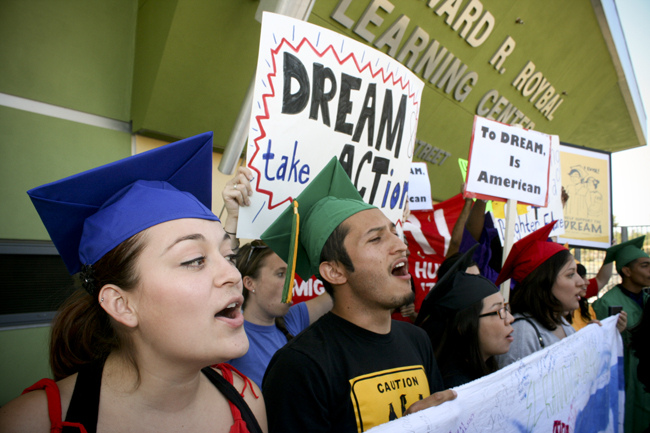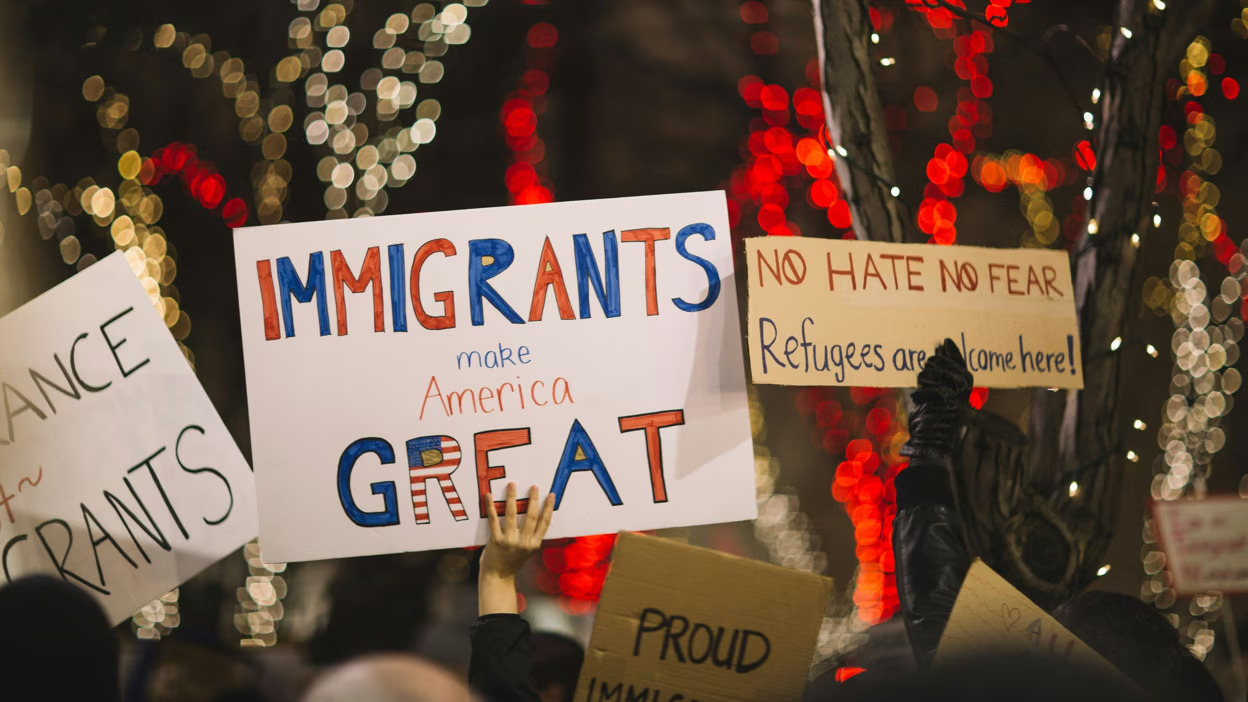With the unsuccessful rescission of the Deferred Action for Children Arrivals (DACA) initiative in September 2017, there has been renewed pressure on Congress to pass federal legislation known as the Dream Act to protect young immigrants who are vulnerable to deportation. This fact sheet provides an overview of the DACA initiative following the Supreme Court’s decision blocking the program’s rescission, the Dream Act and similar legislative proposals, and provides information about policies at the state level that support Dreamers.
Deferred Action for Childhood Arrivals
On June 15, 2012, then-Secretary of Homeland Security Janet Napolitano created Deferred Action for Childhood Arrivals (DACA). DACA is an exercise of prosecutorial discretion, providing temporary relief from deportation (deferred action) and work authorization to certain young undocumented immigrants brought to the United States as children. DACA has enabled almost 800,000 eligible young adults to work lawfully, attend school, and plan their lives without the constant threat of deportation–usually to an unfamiliar country. Unlike federal legislation, however, DACA does not provide permanent legal status to individuals and must be renewed every two years.
On September 5, 2017, Acting Secretary of Homeland Security Elaine Duke rescinded the 2012 DACA memorandum and announced a “wind down” of DACA. As of that date, no new applications for DACA were accepted. DACA beneficiaries whose status was due to expire before March 5, 2018, were permitted to renew their status for an additional two years if they applied by October 5, 2017. Any person for whom DACA would have expired as of March 6, 2018, would no longer have deferred action or employment authorization. The attempted rescission was challenged by U.S. district courts in California, New York, Maryland, and the District of Columbia.
The U.S. Supreme Court agreed to review the legal challenges of the lower courts during its 2019-2020 term. On June 18, 2020, the Court ultimately ruled in a 5-4 decision that the Trump administration’s attempt to terminate the program was unlawful, reasoning that the administration failed to properly explain its decision or consider alternatives to a full rescission of the initiative in violation of the Administrative Procedure Act (APA). However, the Court also recognized that the federal government ultimately retains the legal authority to end the DACA initiative if it were to do so in compliance with the APA.
Following the Supreme Court’s decision, as well as a federal court order issued on July 17, 2020, the DACA program was technically restored to its state prior to the September 2017 rescission. This brought hope to the many people who aged into the initiative—particularly those who reached the minimum age requirement of 15 in the past couple of years while the litigation was ongoing. U.S. Citizenship and Immigration Services (USCIS) subsequently began accepting some initial DACA requests and applications for advance parole but failed to approve or adjudicate any of these forms. Approximately six weeks after the Supreme Court’s decision, Acting Secretary of Homeland Security Chad Wolf issued a memorandum making major changes to the DACA initiative.
Acting Secretary Wolf’s July memorandum rescinds former Acting Secretary Duke’s memorandum from 2017 and makes several significant changes to the operation of DACA. As of June 28, 2020, current and prior DACA recipients can continue to apply to renew their protections with USCIS. The validity period for those protections has been reduced to one year, however, and DACA recipients will now have to apply to renew their protections annually, rather than every two years. USCIS will reject all pending and future initial DACA requests from people who are eligible for DACA but have not previously participated in the initiative, as well as all pending and future applications for advance parole that fail to present exceptional circumstances. Acting Secretary Wolf’s memorandum also indicates that he is reconsidering the DACA initiative in its entirety and further changes are likely.
On August 21, 2020, USCIS Deputy Director for Policy Joseph Edlow issued a memorandum implementing Acting Secretary Wolf’s directive. Deputy Director Edlow’s memorandum clarifies that USCIS will continue to accept and adjudicate DACA requests from all previous DACA recipients, including those who may have failed to renew their protections within one year of the expiration of their last DACA period. The memo also confirms that USCIS will no longer accept renewal requests submitted more than 150 days in advance of the expiration of an applicant’s current DACA protections. Further, Deputy Director Edlow’s memorandum indicates that USCIS is in the process of considering the merits and feasibility of reducing DACA-related fees during the period while the initiative is under review. Finally, the memorandum clarifies the new standard for the consideration of advance parole submitted by DACA recipients.
The Dream Act
The first version of the Development, Relief, and Education for Alien Minors (DREAM) Act was introduced in 2001. As a result, young undocumented immigrants have since been called “Dreamers.” Over the last 19 years, at least ten versions of the Dream Act have been introduced in Congress. While the various versions of the Dream Act have contained some key differences, they all would have provided a pathway to legal status for undocumented youth who came to this country as children. Some versions have garnered as many as 48 co-sponsors in the Senate and 152 in the House.
Despite bipartisan support for each bill, none has become law. The bill came closest to full passage in 2010 when it passed the House of Representatives but fell just five votes short of the 60 necessary to proceed in the Senate.
In July 2017, Senators Lindsay Graham (SC) and Richard Durbin (IL) introduced a version of the Dream Act in the Senate and Representatives Lucille Roybal-Allard (CA) and Ileana Ros-Lehtinen (FL) introduced a partner version in the House of Representatives. That year, members of the House introduced several other legislative proposals to address the legal status of undocumented youth, most of which were variants of the Dream Act. Although some of these bills drew significant support, none became law.
Current Federal Legislative Proposals
The most recent version of the Dream Act, H.R. 2820, was introduced in May 2019 in the House by Rep. Roybal-Allard. The House Judiciary Committee passed H.R. 2820 on May 22, 2019, and the bill was subsequently combined with H.R. 2821, the American Promise Act of 2019, to form H.R. 6, the American Dream and Promise Act of 2019. H.R. 6 would provide permanent legal status for Dreamers as well as beneficiaries of two humanitarian programs: Temporary Protected Status (TPS) and Deferred Enforced Departure (DED). H.R. 6 passed the House on June 4, 2019, by a vote of 237 to 187.
What Would the Dream Act Do?
The American Dream and Promise Act of 2019 would provide current, former, and future undocumented high-school graduates and GED recipients a pathway to U.S. citizenship through college, work, or the armed services. The Act outlines a three-step process, summarized below.
Step 1: Conditional Permanent Residence
An individual would be eligible to obtain conditional permanent resident (CPR) status for up to 10 years, which includes work authorization, if the person:
- entered the United States under the age of 18;
- entered four years prior to bill enactment and has since been continuously present;
- has been admitted to an institution of higher education or technical education school, has graduated high school or obtained a GED, or is currently enrolled in secondary school or a program assisting students to obtain a high school diploma or GED;
- has not been convicted of any “crime involving moral turpitude” or controlled substance offense, any crime punishable by more than one year in prison, or three or more offenses under state or federal law. There is an exception for offenses which are essential to a person’s immigration status; and
- has not been convicted of a crime of domestic violence unless the individual can prove the crime was related to being the victim of domestic violence, sexual assault, stalking, child abuse, neglect in later life, human trafficking, battery, or extreme cruelty.
Under the terms of the bill, the Secretary of Homeland Security can issue waivers for humanitarian purposes, for family unity, or when the waiver is otherwise in the public interest. In addition, anyone who currently has DACA would be granted a swift path to CPR status.
Step 2: Lawful Permanent Residence
Anyone who maintains CPR status could obtain lawful permanent residence (LPR status or a “green card”) by satisfying one of the following requirements.
- Higher education: the person completed at least two years, in good standing, of higher education or of a program leading to a certificate/credential from an area career and technical education school;
- Military service: the person completed at least two years of military service with an honorable discharge, if discharged; or
- Work: the person demonstrated employment over a total period of three years and at least 75 percent of that time the individual had employment authorization, with exceptions for those enrolled in higher education or technical school.
Individuals who cannot meet one of these requirements could apply for a “hardship waiver” if the applicant is a person with disabilities; a full-time caregiver of a minor child; or for whom removal would cause extreme hardship to a spouse, parent, or child who is a national or lawful permanent resident of the United States.
Step 3: Naturalization
After maintaining LPR status for five years, an individual can generally apply to become a U.S. citizen through the normal naturalization process.
According to the Migration Policy Institute, as many as 2.31 million individuals would qualify for conditional permanent resident status under the 2019 version of the Dream Act, putting them on a path to citizenship. The bill would also provide a path to citizenship for an estimated 429,000 people who are current or former beneficiaries of TPS or DED.
State Policies That Protect Dreamers
States cannot legalize the status of undocumented immigrants, but they may address collateral issues that stem from being undocumented. All 50 states and the District of Columbia permit DACA recipients to be issued driver’s licenses. Numerous states enacted legislation to help many Dreamers overcome barriers to higher education and employment. Pursuant to some state laws and policies, many Dreamer students may be able to attend state universities and qualify for in-state tuition and/or financial aid. Some may also qualify for licenses for certain professional or trade occupations.
Colleges and universities each have their own policies about admitting undocumented students; some deny Dreamers admission, while others allow them to attend. Even when undocumented students are allowed to attend college, however, the tuition is often prohibitively expensive. If students cannot prove legal residency in a state, they must pay the much higher out-of-state or international-student tuition rates. Further, undocumented students do not qualify for federal student loans, work study, or other financial assistance. As a result, it is extremely difficult for undocumented students to afford to attend public universities.
To help undocumented students afford college, at least 19 states have passed laws that provide them with the opportunity to receive in-state tuition. California, Colorado, Connecticut, Florida, Illinois, Kansas, Maryland, Minnesota, Nebraska, New Jersey, New Mexico, New York, Oklahoma, Oregon, Rhode Island, Texas, Utah, Virginia, and Washington permit undocumented students who have attended and graduated from the state’s primary and secondary schools to pay the same college tuition as other state residents. The laws generally require undocumented students to attend a school in the state for a certain number of years and graduate from high school in the state.
Many professional and trade industries–such as medicine, education, or cosmetology—require licensure to practice in certain states. Under federal law, undocumented immigrants are barred from receiving a professional license, unless legislation is implemented within individual states permitting their issuance. Thirteen states extend certain professional licenses to undocumented immigrants: Arkansas, California, Florida, Illinois, Michigan, Minnesota, Nebraska, New York, Nevada, South Dakota, Utah, West Virginia, and Wyoming.

